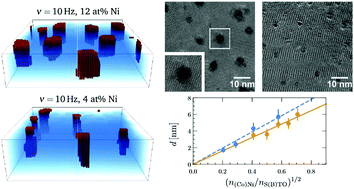Growth of vertically aligned nanowires in metal–oxide nanocomposites: kinetic Monte-Carlo modeling versus experiments
Abstract
We employ kinetic Monte-Carlo simulations to study the growth process of metal–oxide nanocomposites obtained via sequential pulsed laser deposition. Using Ni–SrTiO3 (Ni–STO) as a model system, we reduce the complexity of the computational problem by choosing a coarse-grained approach mapping Sr, Ti and O atoms onto a single effective STO pseudo-atom species. With this ansatz, we scrutinize the kinetics of the sequential synthesis process, governed by alternating deposition and relaxation steps, and analyze the self-organization propensity of Ni atoms into straight vertically aligned nanowires embedded in the surrounding STO matrix. We finally compare the predictions of our binary toy model with experiments and demonstrate that our computational approach captures fundamental aspects of self-assembled nanowire synthesis. Despite its simplicity, our modeling strategy successfully describes the impact of relevant parameters like the concentration or laser frequency on the final nanoarchitecture of metal–oxide thin films grown via pulsed laser deposition.



 Please wait while we load your content...
Please wait while we load your content...